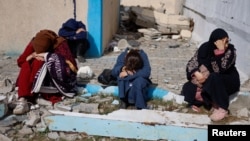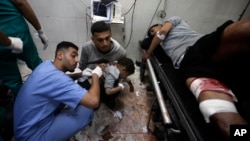The World Health Organization warns that Gaza’s health system is hanging by a thread as health facilities throughout the Palestinian enclave cease to function, restrictions to access increase, medical supplies dwindle and cuts in other humanitarian aid essential for patient care grow.
Gaza’s Nasser Hospital in Khan Younis, where an Israeli military operation is ongoing, is one of the latest casualties. WHO, together with the U.N. Office for the Coordination of Humanitarian Affairs (OCHA), and the Palestine Red Crescent Society, recently conducted a high-risk mission to the medical facility to bring fuel and other essential supplies and evacuate patients in danger from the facility.
“The transfer of patients was requested by the hospital staff after the facility became nonfunctional following a military raid February 14, after a week-long siege,” WHO spokesman Tarik Jasarevic said Tuesday.
“Weak and frail patients were transferred amidst active conflict near the aid convoy. Road conditions hindered the swift movement of ambulances, placing the health of patients at further risk,” he said.
Rik Peeperkorn, WHO representative for the Occupied Palestinian Territory who was part of the medical team, said the three-day mission was frustrated at every turn by military personnel around the compound.
In a telephone interview from Cairo on Monday, Peeperkorn told VOA that his team had requested access to the hospital several times to talk to the staff, “do a quick medical assessment, plan a medical evacuation and transfer patients when needed.”
He said the team was not allowed access for the first two days but was granted access to the hospital on the third day. He said the team managed to transfer 14 critical patients — eight nonwalking and six walking, along with two patient companions — to four other hospitals in the area.
WHO estimates that 130 sick and injured patients and at least 15 doctors and nurses remain inside the hospital.
Peeperkorn described conditions in the hospital as dire and deteriorating.
“The ICU is not functional," he said. “The hospital has no electricity. We brought in some medical supplies. It has actually very little food and water, no basic supplies for oxygen, no running water, and there is garbage everywhere, creating a breeding ground for disease. There is also heavy damage everywhere.
“The limb reconstruction, which was the pride of Nasser Medical Complex, where a lot of amputations were prevented by excellent surgeons, is not functional anymore. Currently, you can say that the hospital, which is the largest referral hospital south of central Gaza, is not functional,” he said.
OCHA reports that the situation in Al Amal Hospital, also in Khan Younis, is also critical, following a four-week siege by the Israeli military. Food supplies reportedly are almost exhausted, and fuel reserves are dwindling.
Another serious issue is malnutrition. A joint WHO, UNICEF, World Food Program report issued Monday warns that “a steep rise in malnutrition among children and pregnant and breastfeeding women in Gaza Strip poses grave threats to their health.”
It finds that 15% or one in six children under the age of 2 is acutely malnourished. Of those, almost 3% suffer from severe wasting. The report says that is “the most life-threatening form of malnutrition, which puts young children at highest risk of medical complications and death unless they receive urgent treatment.”
Peeperkorn notes that before Israel’s invasion of Gaza, following Hamas’ brutal attack on Israel on October 7, in which 1,200 people were killed and 240 taken hostage, “malnutrition was never an issue in Gaza,” adding that currently, particularly in the north, “we are seeing incredibly concerning cases of malnutrition among children.”
But looming over those and myriad other problems is the fear of a military incursion by Israel on Rafah in southern Gaza, where 1.5 million people are living in overcrowded, unsanitary conditions.
Israeli Prime Minister Benjamin Netanyahu has said the military operation will go ahead at the start of Ramadan in three weeks if Hamas does not release the hostages.
“Fear is what I read in all peoples’ eyes, including in my national staff and their families,” Peeperkorn told VOA. “Like everyone else in Gaza, they have been forced to move four, five, six times, forced to flee from the north and middle area to the so-called safer area in the south.
“There is no place safe in Gaza. There are approximately 1.5 million people in Rafah. Where do these people go? There is no place to go,” he said.
“When we are talking about an incursion on Rafah, we are talking about a humanitarian disaster on top of another ongoing humanitarian disaster. That is unthinkable. It will have a terminal, catastrophic effect if that were to happen,” Peeperkorn said.








